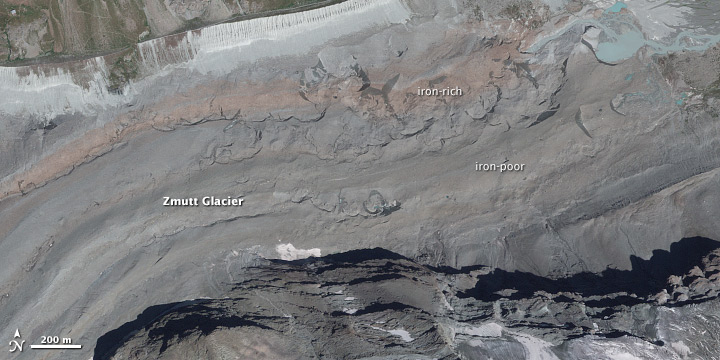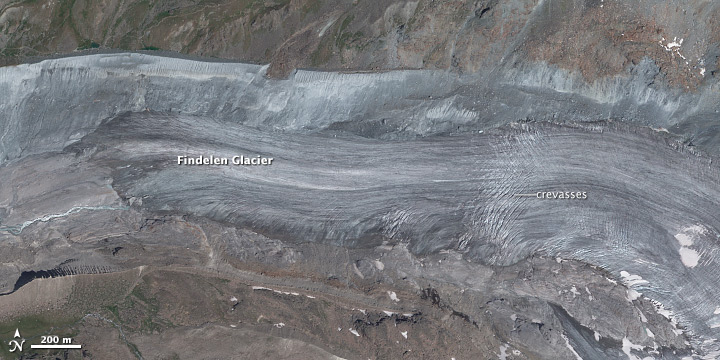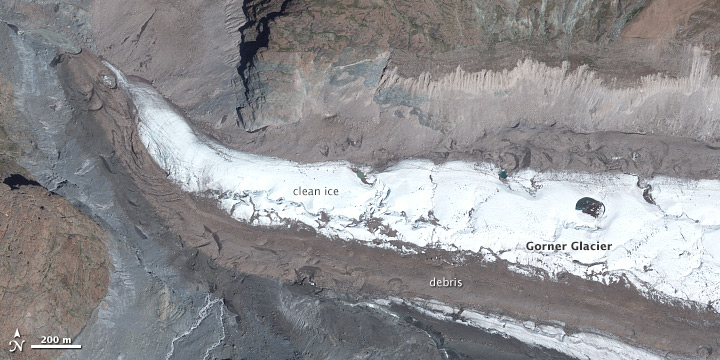
acquired August 18, 2009

acquired August 18, 2009
For a short time after a snowfall,
glaciers are like blank white canvases. But it’s not long before the
snowy surfaces are painted over with coats of dust, soot, ash, pollen,
salt, sand, rocks, and other debris.
Nature has more than one paintbrush at its disposal. Winds can blow
in plumes of smoke and dust to coat surfaces with black, gray, metallic,
even reddish or yellow tones. Volcanoes spew dark ash and tephra that
can be millimeters to meters thick. And landslides and lahars slosh
thick layers of soil, pulverized rock, muck, and sediment on the icy
canvases.
In the case of Zmutt Glacier, which is in the Swiss Alps near the base of the Matterhorn,
debris comes from rockfalls from the steep terrain that hems the
glacier in at the bottom of Zmutt Valley. The rockfalls send debris
ranging from pebbles to large boulders tumbling down onto the ice in a
rush. Winds blow pulverized rock flour and dust onto the glacier as well.
The top image shows the debris-covered surface of Zmutt Glacier, as seen by a sensor aboard the GeoEye-1
satellite on August 18, 2009. Debris bands with different geochemical
compositions are visible. The rust-colored band near the top of the
image is iron-rich; the gray bands south of it are iron-poor. The color
difference relates to the composition of the rock to the north and the
south of the glacier. The outcrop to the north is rich with minerals
that interact with rainwater to produce an acidic environment on rock
surfaces that leads to rapid chemical weathering
of rock, while the combination of minerals in the outcrop to the south
produces a less acidic environment that slows weathering.
For comparison, the upper image shows the surface of Findelen
Glacier, which is a few miles east of Zmutt Glacier near the town of Zermatt.
While Findelen has some fine dust on it, it lacks the thicker debris
bands seen on Zmutt Glacier. The bottom image shows Gorner Glacier,
another valley glacier near Zermatt. Like Zmutt Glacier, its surface has
distinct banding, with clean ice sandwiched between debris on its
northern and southern edges.
NASA scientist Kimberly Casey has developed new methods to map the
composition of glacial debris using satellites. Since the composition of
debris can affect the rate that glaciers retreat, her research could
help answer long-standing, controversial questions about the impact of
climate change on glaciers. To learn more, read the Earth Observatory’s
new feature: “Painted Glaciers.”
References
- Casey, K. and Kääb, A. (2012, September 7) Estimation of Supraglacial Dust and Debris Geochemical Composition via Satellite Reflectance and Emissivity. Remote Sensing, 4 (9), 2554-2575.
- NSIDC Zmutt Glacier. Accessed July 10, 2013.
- UNEP (2008, September 1) Global Glacier Changes: Facts and Figures, Central Europe. (pdf). Accessed July 10, 2013.
- Wei, Z. (2010) Chemical evolution at surface condition in the Zermatt-Saas area (Swiss Alps): A geo-hydrochemistry study on surface water-rock interaction (pdf). Accessed July 10, 2013.
Images based on GeoEye-1 data ©2009 Digital Globe. Caption by Adam Voiland.
- Instrument:
- GeoEye
NASA: Switzerland - Distinct Faces of Zmutt. Findelen. and Gorner Glaciers. Near the base of the Matterhorn - 22.07.13
Ricardo M Marcenaro - Facebook
Blogs of The Solitary Dog:
solitary dog sculptor:
http://byricardomarcenaro.blogspot.com
Solitary Dog Sculptor I:
http://byricardomarcenaroi.blogspot.com
Para:
comunicarse conmigo,
enviar materiales para publicar,
propuestas:
marcenaroescultor@gmail.com
For:
contact me,
submit materials for publication,
proposals:
marcenaroescultor@gmail.com
My blogs are an open house to all cultures, religions and countries. Be a follower if you like it, with this action you are building a new culture of tolerance, open mind and heart for peace, love and human respect.
Thanks :)
Mis blogs son una casa abierta a todas las culturas, religiones y países. Se un seguidor si quieres, con esta acción usted está construyendo una nueva cultura de la tolerancia, la mente y el corazón abiertos para la paz, el amor y el respeto humano.
Gracias :)
solitary dog sculptor:
http://byricardomarcenaro.blogspot.com
Solitary Dog Sculptor I:
http://byricardomarcenaroi.blogspot.com
Para:
comunicarse conmigo,
enviar materiales para publicar,
propuestas:
marcenaroescultor@gmail.com
For:
contact me,
submit materials for publication,
proposals:
marcenaroescultor@gmail.com
My blogs are an open house to all cultures, religions and countries. Be a follower if you like it, with this action you are building a new culture of tolerance, open mind and heart for peace, love and human respect.
Thanks :)
Mis blogs son una casa abierta a todas las culturas, religiones y países. Se un seguidor si quieres, con esta acción usted está construyendo una nueva cultura de la tolerancia, la mente y el corazón abiertos para la paz, el amor y el respeto humano.
Gracias :)


No hay comentarios:
Publicar un comentario